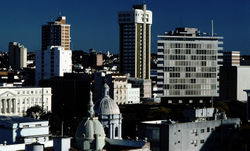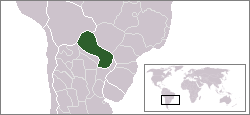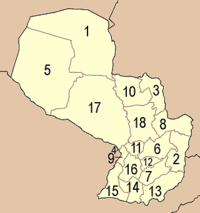Paraguay
2007 Schools Wikipedia Selection. Related subjects: Central & South American Countries; Countries
| República del Paraguay Tetã Paraguái Republic of Paraguay |
|||||
|
|||||
| Motto: Spanish: Paz y justicia (English: "Peace and justice") |
|||||
| Anthem: Paraguayos, República o Muerte | |||||
| Capital (and largest city) |
Asunción |
||||
| Official languages | Spanish, Guaraní | ||||
|---|---|---|---|---|---|
| Government | Presidential republic | ||||
| - President | Nicanor Duarte Frutos | ||||
| - Vice President | Luis Castiglioni Joria | ||||
| Independence | From Spain | ||||
| - Declared | May 14, 1811 | ||||
| Area | |||||
| - Total | 406,752 km² ( 59th) 157,047 sq mi |
||||
| - Water (%) | 2.3% | ||||
| Population | |||||
| - July 2005 estimate | 6,158,000 ( 101st) | ||||
| - Density | 15/km² ( 192nd) 39/sq mi |
||||
| GDP ( PPP) | 2005 estimate | ||||
| - Total | $28.342 billion ( 96th) | ||||
| - Per capita | $4,555 ( 107th) | ||||
| HDI (2004) | 0.757 (medium) ( 91st) | ||||
| Currency | Guaraní ( PYG) |
||||
| Time zone | ( UTC-4) | ||||
| - Summer ( DST) | ( UTC-3) | ||||
| Internet TLD | .py | ||||
| Calling code | +595 | ||||
Paraguay, officially the Republic of Paraguay (Spanish: República del Paraguay, pron. IPA [re'puβlika del para'ɣwaj], Guarani: Tetã Paraguái), is a landlocked country in South America. It lies on both banks of the Paraguay River, bordering Argentina to the south and southwest, Brazil to the east and northeast, and Bolivia to the northwest, and is located in the very heart of South America. 'Paraguay' is derived from the Guaraní word 'Pararaguay', meaning, 'From a Great River'. The 'Great River' is the Paraná River, which produces the greatest amount of hydroelectric power in the world.
History
Europeans first arrived in the area in the early 16th century and the settlement of Asunción was founded on August 15, 1537, by the Spanish explorer Juan de Salazar. The city eventually became the centre of a Spanish colonial province, as well as a primary site of the Jesuit missions and settlements in South America in the 18th century. Paraguay declared its independence by overthrowing the local Spanish authorities on May 14, 1811.
Paraguay's history has been characterized by long periods of authoritarian governments, political instability and infighting, and devastating wars with its neighbors. Its post-colonial history can be roughly be divided into several distinct periods:
- 1811 - 1816: The Birth of a Nation
- 1816 - 1840: José Gaspar Rodríguez de Francia governments
- 1840 - 1865: Carlos Antonio Lopez & Francisco Solano Lopez governments
- 1865 - 1870: The War of the Triple Alliance
- 1870 - 1904: Post-war reconstruction and Colorado Party governments
- 1904 - 1932: Liberal Party governments and run-up to the Chaco War
- 1932 - 1935: Chaco War
- 1935 - 1940: Revolutionary Febrerista Party, and Jose Felix Estigarribia governments
- 1940 - 1948: Higinio Morinigo government
- 1948 - 1954: Paraguayan Civil War, re-emergence of the Colorado Party
- 1954 - 1989: Alfredo Stroessner dictatorship
- 1989 - Present: The Road Less Traveled -- Transition to Democracy
The War of the Triple Alliance and the Chaco War are milestones in Paraguay's history, since Paraguay's independence from Spain was a rather bloodless affair. Paraguay fought the War of the Triple Alliance against Brazil, Argentina and Uruguay, and was defeated in 1870 after five years of the bloodiest war in South America. Paraguay suffered extensive territorial losses to Brazil and Argentina. The Chaco War was fought with Bolivia in the 1930s and Bolivia was defeated. Paraguay re-established sovereignty over the region called the Chaco, and forfeited additional territorial gains as a price of peace.
The history of Paraguay is fraught with disputes among historians, educators and politicians. The official version of historical events, wars in particular, varies depending on whether you read a history book written in Paraguay, Argentina, Brazil or Bolivia. Even European and American authors have been unable to avoid bias. Paraguay's history also has been a matter of dispute among Paraguay's main political parties, and there is a Colorado Party and Liberal Party official version of Paraguayan history.
Politics
Politics of Paraguay takes place in a framework of a presidential representative democratic republic, whereby the President of Paraguay is both head of state and head of government, and of a pluriform multi-party system. Executive power is exercised by the government. Legislative power is vested in both the government and the two chambers of the National Congress. The Judiciary is independent of the executive and the legislature.
Administrative divisions
Paraguay consists of 17 departments and one capital district (distrito capital). These are, with their capitals indicated in parentheses:
|
|
Economy
Paraguay has a market economy marked by a large informal sector that features both re-export of imported consumer goods to neighbouring countries, and thousands of small business enterprises. Paraguay's largest economic activity is based on agriculture, agribusiness and cattle ranching. Paraguay is ranked as the world's third largest exporter of soybeans, and its beef exports are substantial for a country of its size. A large percentage of the population derive their living from agricultural activity, often on a subsistence basis.
Paraguay's economic potential has been historically constrained by its landlocked geography, but it does enjoy access to the Atlantic Ocean via the Paraná River. Due to its meditereanity, Paraguay's economy is very dependent on Brazil and Argentina, its neighbours to the east, south and west. Through various treaties, Paraguay has been granted free ports in Argentina, Uruguay and Brazil through which it sends its exports. The most important of these free port is on the Brazilian Atlantic coast at Paranaguá.
The Friendship Bridge that now spans the Paraná River between Ciudad del Este and the Brazilian city of Foz do Iguaçu permits about 40,000 travelers to commute daily between both cities, and allows Paraguay land acess to Paranaguá. A vibrant economy has developed in Ciudad del Este and Foz de Iguazu mostly based on international commerce and shopping trips by Brazilian buyers colloquially called sacoleiros.
About 60% of the GDP derives from trade and exports to Brazil and Argentina. Despite difficulties arising from political instability, corruption and slow structural reforms, Paraguay has been a member of the free trade bloc MERCOSUR since 1991.
Demographics

Ethnically, culturally, and socially, Paraguay has one of the most homogeneous populations in Latin America. About 95% of the people are mestizos of mixed Spanish and Guaraní Indian descent. The only trace of the original Guaraní culture is the Guaraní language, spoken by 94% of the population. About 75% of all Paraguayans can speak Spanish. Guaraní and Spanish are both official languages. Small groups of Ethnic Italians, Germans, Japanese, Koreans, Chinese, Arabs, Brazilians, and Argentines settled in Paraguay and they have to an extent retained their respective languages and culture - particularly the Brazilians.
Paraguay's population is distributed unevenly throughout the country. About 56% of Paraguayans live in urban areas. The vast majority of the people live in the eastern region near the capital and largest city, Asuncion, that accounts for 10% of the country's population. The Chaco, which accounts for about 60% of the territory, is home to less than 2% of the population.
The country is predominantly Roman Catholic, with some Mennonite and other Protestant minorities.



